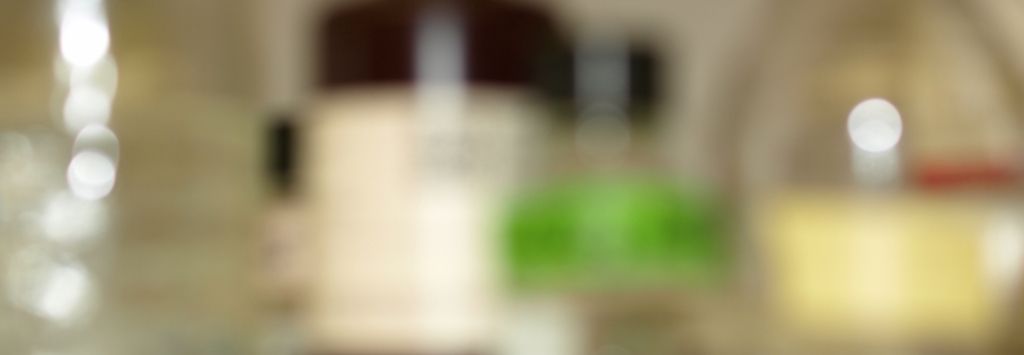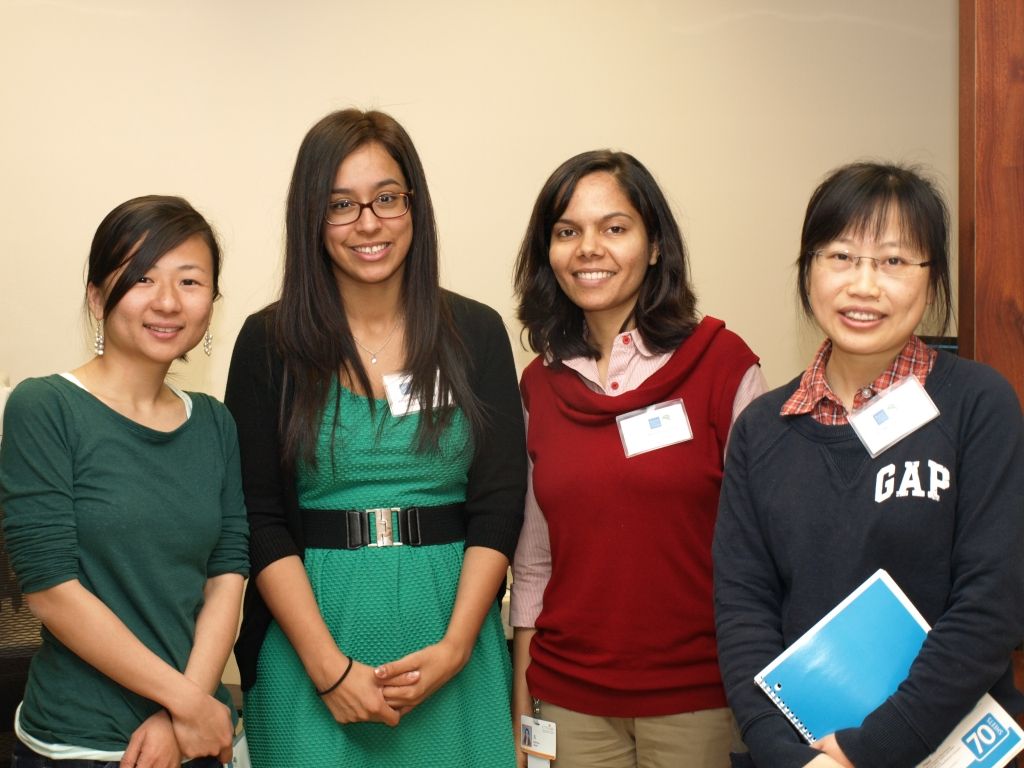- Details
- Written by Gina Vozenilek
- Category: Science & Research
- Hits: 3345
[caption id="attachment_673" align="alignright" width="374"]
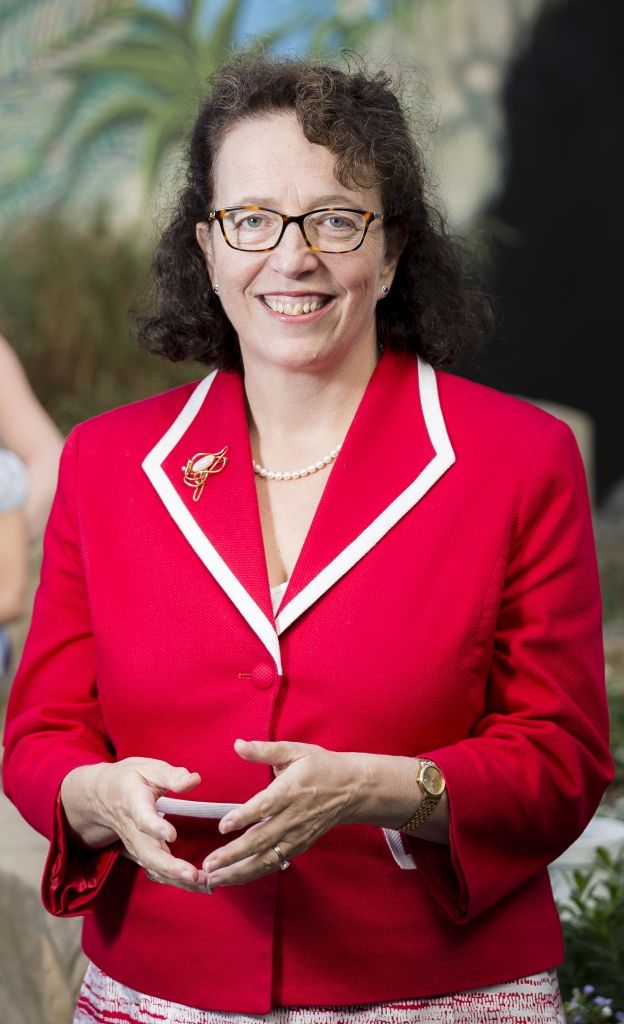 Dr. Ingrid Scheffer[/caption]
Dr. Ingrid Scheffer[/caption]When I got in touch with Dr. Ingrid Scheffer she was away at an epilepsy conference in Bologna, Italy, after having just hosted a major Dravet Syndrome conference in Melbourne. We are very grateful that the globe-trotting epilepsy expert has agreed to participate in the Denver KCNQ2 Summit. As she catches her breath back home in Australia, we will “beam” her in (if she can sit still long enough!).
Professor Scheffer is Chair of Pediatric Neurology Research at The University of Melbourne and Senior Principal Research Fellow at the Florey Institute of Neuroscience and Mental Health. She is a founding fellow of the Australian Academy of Health and Medical Sciences and is currently its Vice-President. She has served the International League Against Epilepsy in many capacities and held the Chair of the ILAE Commission for Classification and Terminology from 2009 until 2013. Read more about her background here.
Dr. Scheffer has received numerous awards for her groundbreaking work. One of her recent accolades is the prestigious 2012 L'Oréal-UNESCO Laureate for Women in Science for the Asia-Pacific Region. These annual awards are given to five women scientists, one from each of five global regions, whose exceptional careers blaze trails for the next generation of women scientists. Dr. Scheffer was the first to win for epilepsy research, and it is rare for this prize to be awarded to a physician-scientist.
[youtube id="bGPhtVpWOWg" width="600" height="350"]
Dr. Scheffer’s work is praised on the UNESCO website:
Ingrid Scheffer is helping to transform the diagnosis and treatment of epilepsy, a brain disorder characterized by seizures and other symptoms that can be extremely disruptive to the lives of the 50 million people affected by it. She has described several new forms of epilepsy and her research group was the first to uncover a gene for epilepsy and subsequently, many of the genes now known to be implicated. These revolutionary findings, which have already improved diagnosis and treatments for many patients and may lead to the development of new therapies, can also be used for genetic counselling. Professor Scheffer’s goal is to ‘make a major difference to patients and families through science’.
Professor Scheffer collaborated with the Belgian group of Dr. Sarah Weckhuysen and Professor Peter de Jonghe to delineate KCNQ2 encephalopathy. There had been a few previous reports of single patients with severe disorders and mutations (abnormalities) of the KCNQ2 gene but the disorder had not been well recognized. Their team identified a group of children and delineated this severe disorder, now recognized worldwide.
Professor Scheffer has worked with the Belgian group to report a second group of patients including a more mildly affected child that she looks after, expanding our understanding of the presentations of this disease. Get a glimpse of Dr. Scheffer's work with the daughter of our good friend Sara James Butcher, in a 30-minute documentary for the "Australian Story" series.
[youtube id="5Krl6H8fw4M" width="600" height="350"]
KCNQ2 encephalopathy is one of the severe epilepsies of infancy and childhood known as developmental epileptic encephalopathies which are now recognized to occur due to mutations in a large number of genes. Typically a child has a mutation in one gene that arises newly in the child and is not inherited from their parents. By recognizing a specific disease such as KCNQ2 encephalopathy, Dr. Scheffer explains, we can learn which medications control seizures and which medications make seizures worse. We can learn about the outcome of this disease and the various medical problems (co-morbidities) that may occur such as autism spectrum disorders, cerebral palsy, sleep and feeding disorders.
Dr. Scheffer says the biggest challenge she faces in her work is finding enough hours in the day to care for her patients and families and to fulfill her other roles of teaching and mentoring young clinicians and researchers and working on her research, let alone her administrative responsibilities in the hospital and university – and finding time to see her own wonderful family and friends. She is passionate about her patients and her research and her dream is to find a cure to these devastating disorders.
- Details
- Written by Gina Vozenilek
- Category: Science & Research
- Hits: 4041
On Wednesday, May 14, advocates for the use of CBD oil in children with severe epilepsy will be gathering in Springfield to urge lawmakers to pass Illinois SB2636, the bill that adds epilepsy as a condition for medical marijuana use. It has already been passed by the Illinois Senate and a House subcommittee. The groundswell of support for SB2636 and similar legislation throughout the country is making headlines every day it seems. Momentum is rolling forward.
Meanwhile, a multicenter clinical trial of a cannabis-derived drug is underway in two medical centers in the US (University of California at San Francisco and New York University) with more centers slated to follow soon. Research clinicians are eager to put some hard science behind the anecdotal testimonies of the benefits of CBD oil for children with epilepsy. But in order for their results to meet the rigorous standards of peer review, researchers are studying Epidiolex, a pharmacological formulation of pure cannabidiol produced by GW Pharmaceuticals.
Dr. Maria Roberta Cilio, MD, PhD, is heading up the study that started in January at the Benioff Children’s Hospital at UCSF. Twenty-five children are enrolled in the trial there. The KCNQ2 community is obviously interested in what these studies will reveal about this emerging treatment option. Dr. Cilio was gracious enough to answer a few questions for us by email.
JA: What are your criteria for enrolling patients?
Dr. Cilio: Patients 1 year to 18 years of age, with intractable seizures resistant to gold standard anti-epileptic drugs.* The patients must have been diagnosed with a well-defined epilepsy type and seizure type(s). Epidiolex will be administered in addition to the patients’ current drug regimen.
JA: How is Epidiolex different from “CBD oil?”
Dr. Cilio: Epidiolex is pure cannabidiol (containing no psychotropic THC). It is a schedule 1, non-FDA approved drug with “orphan drug” status that we are currently trying in order to evaluate effects and side effects. Despite the media and parents' reports about different preparations of CBD oil, there are no accurate data about short- medium- and long-term effects of these preparations. We are trying to gather data about Epidiolex that is a pharmaceutical compound containing pure CBD. For this reason, in order to clearly understand the effects of Epidiolex, patients should not be on any other cannabis-derived preparations. If a trial with Epidiolex is considered, the patient should be off any cannabis-derived product for at least two months. (Italics mine)
JA: What outcomes are you measuring: seizure control only or other effects too? I ask because parents of kids with KCNQ2-related epilepsy are obviously interested in the anecdotes about CBD oil helping kids make gains in cognitive development as well as seizure control.
Dr. Cilio: At this point we are measuring safety, tolerability, and efficacy in regards to seizure control. In regards to the anecdotal reports about children with Dravet using CBD oil and showing improvement in cognition, this needs to be confirmed with neuropsychological studies done prior to and after treatment. When a child with treatment-resistant seizures becomes seizure-free or experiences a marked decrease in seizure frequency with any medication, the first hypothesis that comes to my mind is that the gain in cognitive development is due to the seizure freedom or seizure reduction. I would call for caution at this point in stating that CBD improves cognitive function. I believe that accurate data are first needed regarding safety, tolerability, and efficacy before any conclusion is made. The great excitement in the media as well as among parents about this drug and other cannabis-derived compounds must be taken into account when outcomes from uncontrolled studies are evaluated. Randomized placebo-controlled trials of Epidiolex or other cannabis-derived compounds will help in overcoming potential biases and provide the most valuable information regarding seizure control and cognitive function improvement.
* In regards to her experience with patients with KCNQ2-related epilepsy, Dr. Cilio also notes: “In my experience, most children with KCNQ2 mutations have a low seizure frequency after the first years of life, or are seizure free. In my experience they respond well to carbamazepine. I believe that the potassium-channel opener Retigabine/Exogabine has a potential in treating KCNQ2-related epilepsy, since this drug can target the molecular disorder.”
One final note: although Dr. Cilio's full roster of patients in this study does not include any children with KCNQ2-related epilepsy, she does not exclude the possibility that at other centers KCNQ2 kids might be enrolled if they meet the criteria. We look forward to that day, and we will be keeping you posted!
- Details
- Written by Gina Vozenilek
- Category: Science & Research
- Hits: 539816
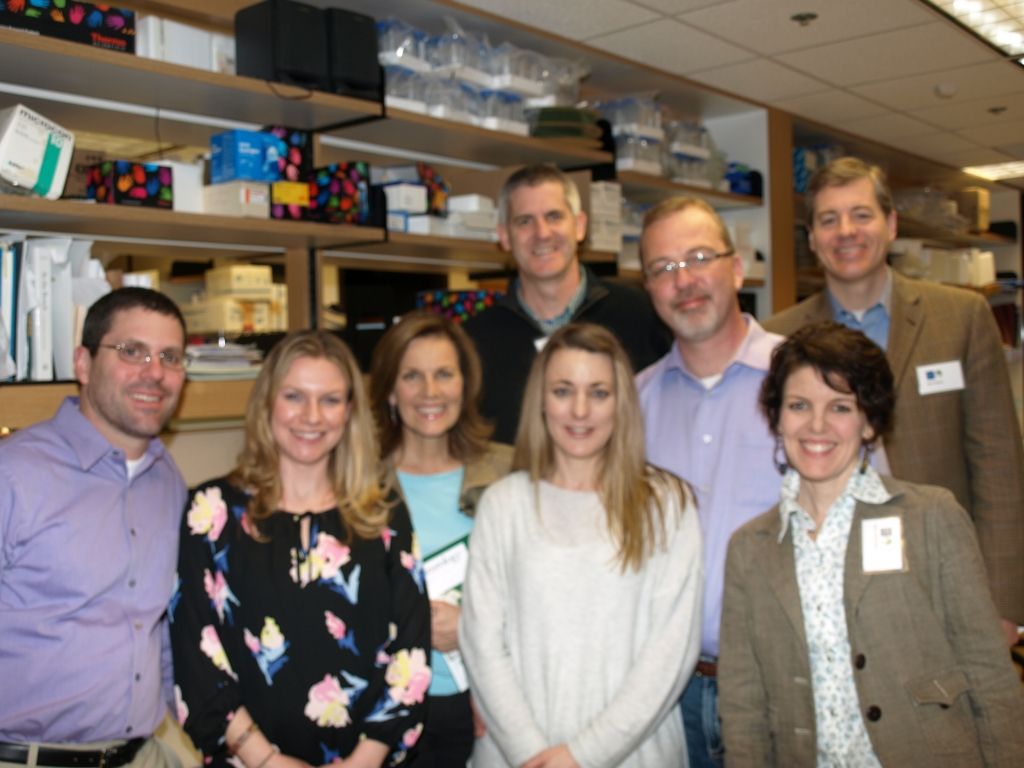 In the Cooper Lab (L-R, front row) Mike and Liz Pribaz, Sara James Butcher, Scotty Sims, Gina Vozenilek; (back row) Brian Baird, Jim Johnson, Eric Pierce[/caption]
In the Cooper Lab (L-R, front row) Mike and Liz Pribaz, Sara James Butcher, Scotty Sims, Gina Vozenilek; (back row) Brian Baird, Jim Johnson, Eric Pierce[/caption]Narrowly dodging a late season snowstorm, members of Jack’s Army convened in sunny Houston at the Baylor College of Medicine on Thursday, March 13. The Chicago contingent (Mike and Liz Pribaz, Brian Baird, Eric Pierce, Laura Javech, and me, Mike’s sister Gina) was joined by friends Jim Johnson and Scotty Sims and their daughter Harper from Denver and Sara James Butcher from Australia by way of New York. We came for a series of presentations, conversations, and tours at Dr. Ed Cooper’s Molecular Neuropharmacology Lab, or the Cooper Lab, the hub of KCNQ2-related epilepsy research.
[caption id="attachment_361" align="alignright" width="198"]
 Harper and the friendly sound guy[/caption]
Harper and the friendly sound guy[/caption]The gathering was billed as a “retreat day,” which sounded somewhat relaxing to us Chicagoans, who had checked into our hotel the night before at 3 AM (note to readers: if visiting Houston in March during the rodeo http://www.rodeohouston.com/, be sure to book your rooms well in advance!). Energized by curiosity and coffee, we arrived at the laboratory to meet the others in a conference room. William and Destin Sims, Scotty's brother and sister-in-law, were there too. It was great to meet them! They made the trip to help entertain Harper, who wasted no time in entertaining all of us. She was perfectly comfortable with all the commotion, charming everyone.
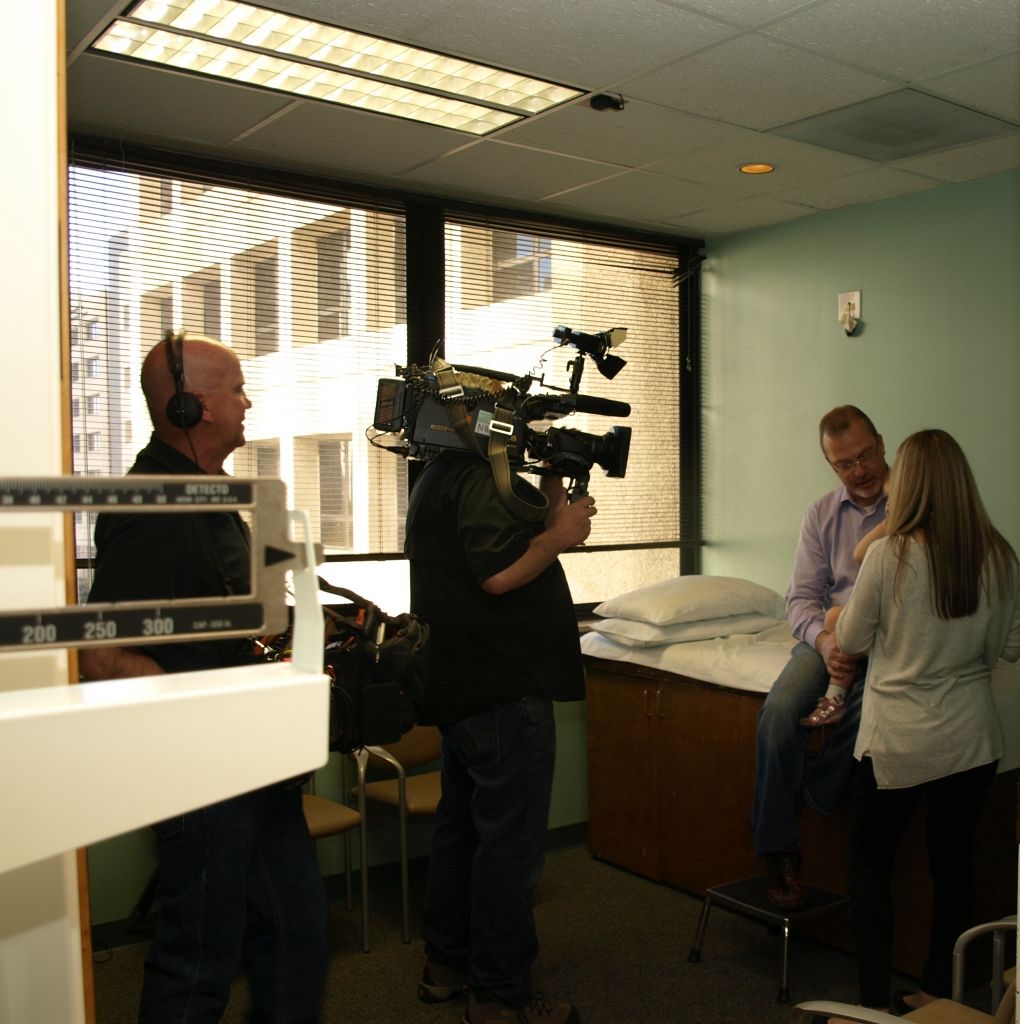 Breaking News!
Breaking News!After introductions we prepared to dive into a tidy agenda prepared by Dr. Cooper. But sometimes things don’t go exactly according to plan, and sometimes that’s a good thing. In this case, it was a great thing. Our orderly schedule of events went out the window as a camera crew from the NBC affiliate in Houston arrived to film the parents and researchers. You can watch the segment that aired on the Houston 4:00 news that afternoon here. Our thanks to the production crew from Click2Houston News for doing such a fantastic job and helping us get the word out about our important little corner of epilepsy research.
 While the Houston news crew was interviewing the parents in the lab, Liz’s phone rang. It was NBC5’s Nesita Kwan in Chicago, calling to arrange a time to film a similar story back home. Click here to watch Nesita's excellent story on Jack's KCNQ2-related epilepsy that aired the next day on NBC5 Chicago.
While the Houston news crew was interviewing the parents in the lab, Liz’s phone rang. It was NBC5’s Nesita Kwan in Chicago, calling to arrange a time to film a similar story back home. Click here to watch Nesita's excellent story on Jack's KCNQ2-related epilepsy that aired the next day on NBC5 Chicago.Meet the Researchers
[caption id="attachment_318" align="alignright" width="266"]
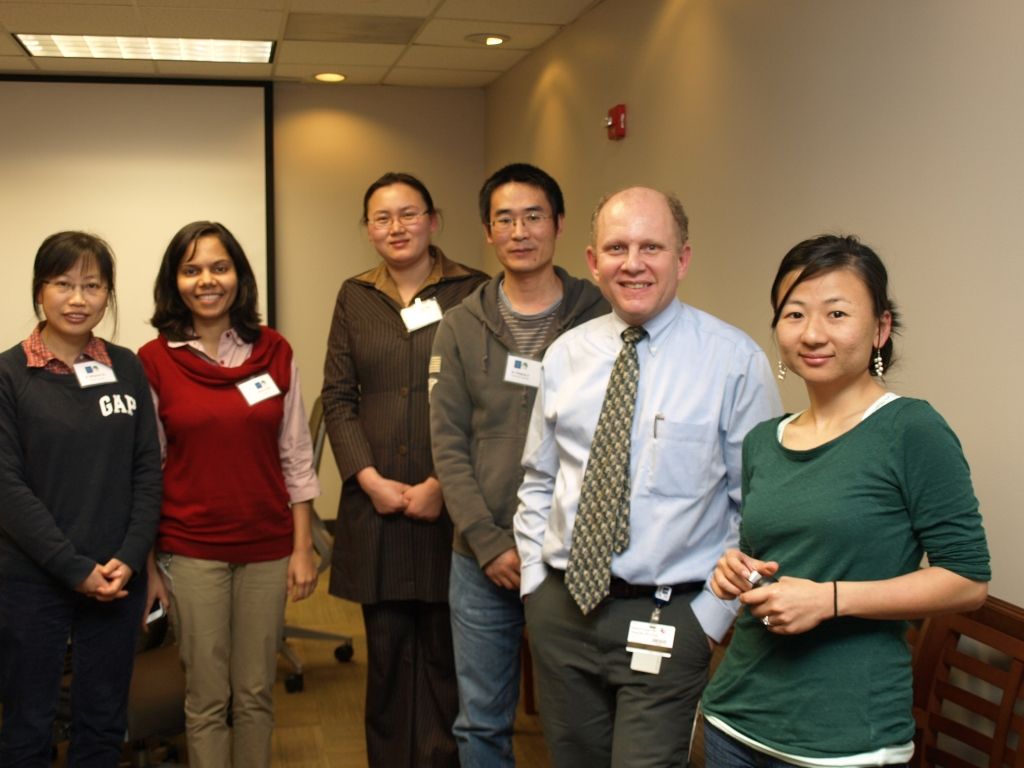 The Cooper Lab Dream Team (L-R): Mingxuan Xu, Nishtha Joshi, Li Li, Zhigang Ji, Ed Cooper, Baouyen Tran, and Angel Lopez (not pictured)[/caption]
The Cooper Lab Dream Team (L-R): Mingxuan Xu, Nishtha Joshi, Li Li, Zhigang Ji, Ed Cooper, Baouyen Tran, and Angel Lopez (not pictured)[/caption]At lunch we had an opportunity to get to know the scientists who work in the Cooper lab. It was wonderful to have the opportunity to break bread and share ideas with such a busy and talented group of scientists. They connected with us over sandwiches and conversation about the next steps we can take together.
Two strategies in particular emerged from these discussions, which will be detailed soon. They involve a collective patient database and the development of a professional conference for researchers worldwide who are studying the KCNQ2 gene. In all instances, bringing people and ideas together is paying off for Jack’s Army.
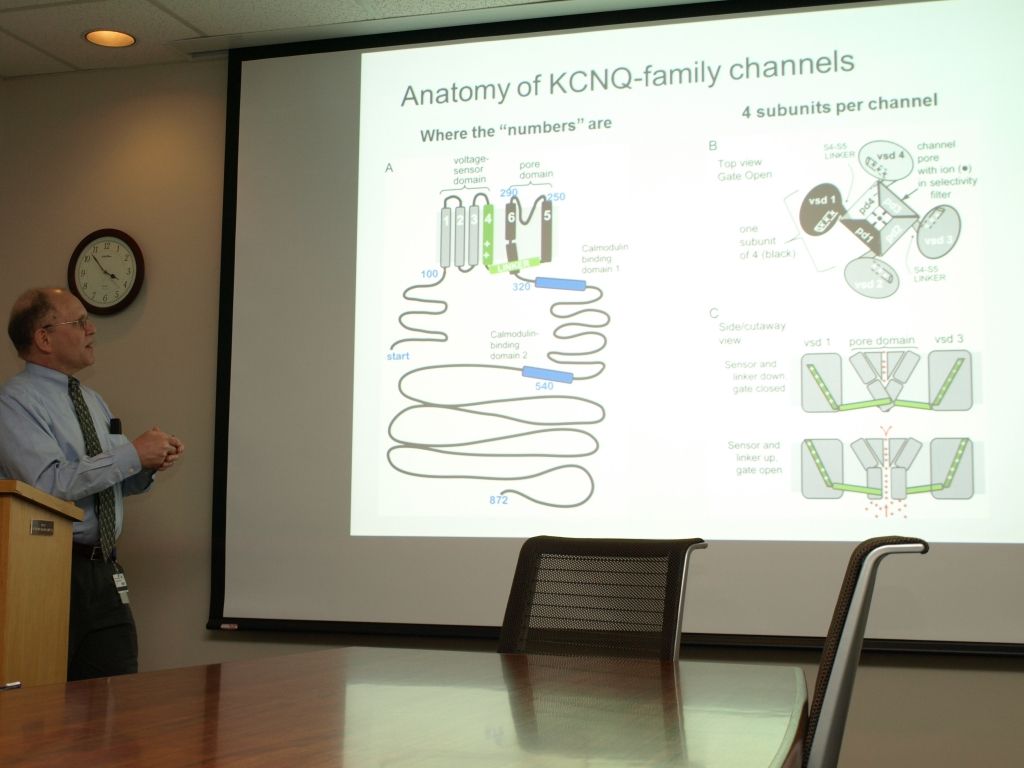 Then it was back to the conference room to learn from each of the scientists about their current projects and findings. Lab scientists do not often present their complicated work to a lay audience like us, but it was clear that they worked hard to create understandable graphics and explanations (and nice animations!). And our blown up schedule from earlier in the day meant that they stayed well into the evening to patiently answer all of our questions. We hope to be able to share some of their educational pieces here on the website in the coming weeks.
Then it was back to the conference room to learn from each of the scientists about their current projects and findings. Lab scientists do not often present their complicated work to a lay audience like us, but it was clear that they worked hard to create understandable graphics and explanations (and nice animations!). And our blown up schedule from earlier in the day meant that they stayed well into the evening to patiently answer all of our questions. We hope to be able to share some of their educational pieces here on the website in the coming weeks.The Cooper Lab team are so obviously invested in advancing the science and bettering the lives of children affected by this genetic epilepsy. We returned home from Houston profoundly moved by the Cooper Lab team’s dedication and are excited by their steady progress. We couldn’t agree more with a note we received from Zhigang: “Let’s fight the disease together.”
Snapshots from the Trip
[caption id="attachment_341" align="aligncenter" width="398"]
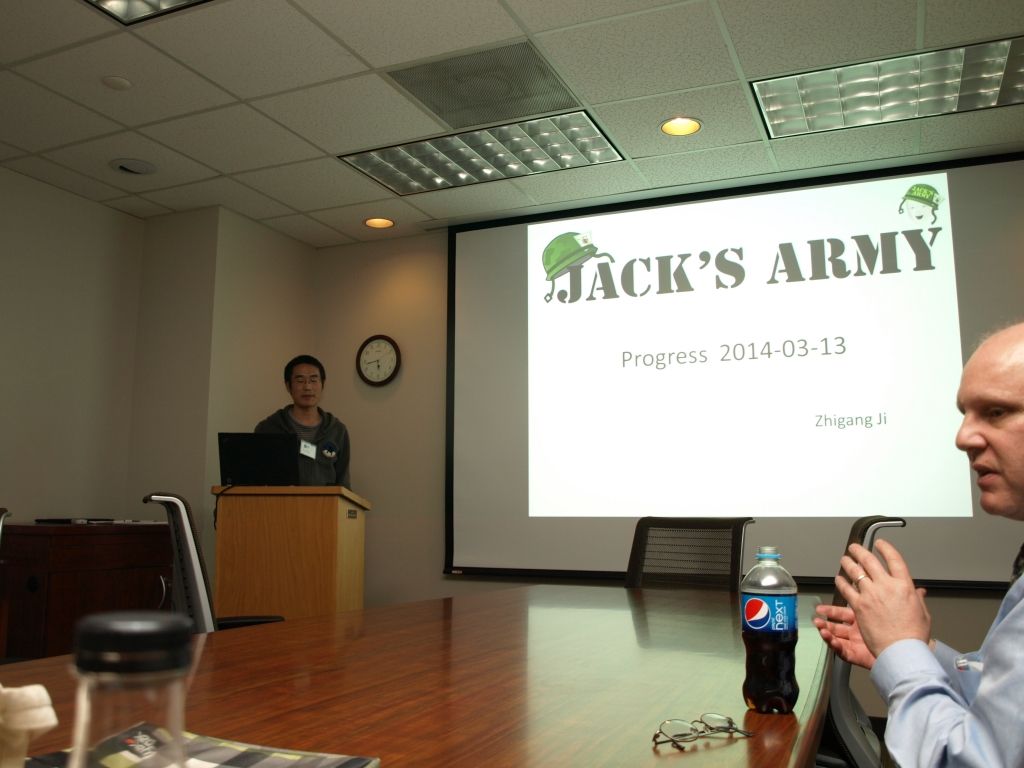 Zhigang Yi shares his findings and outlines his next steps[/caption]
Zhigang Yi shares his findings and outlines his next steps[/caption][caption id="attachment_371" align="aligncenter" width="400"]
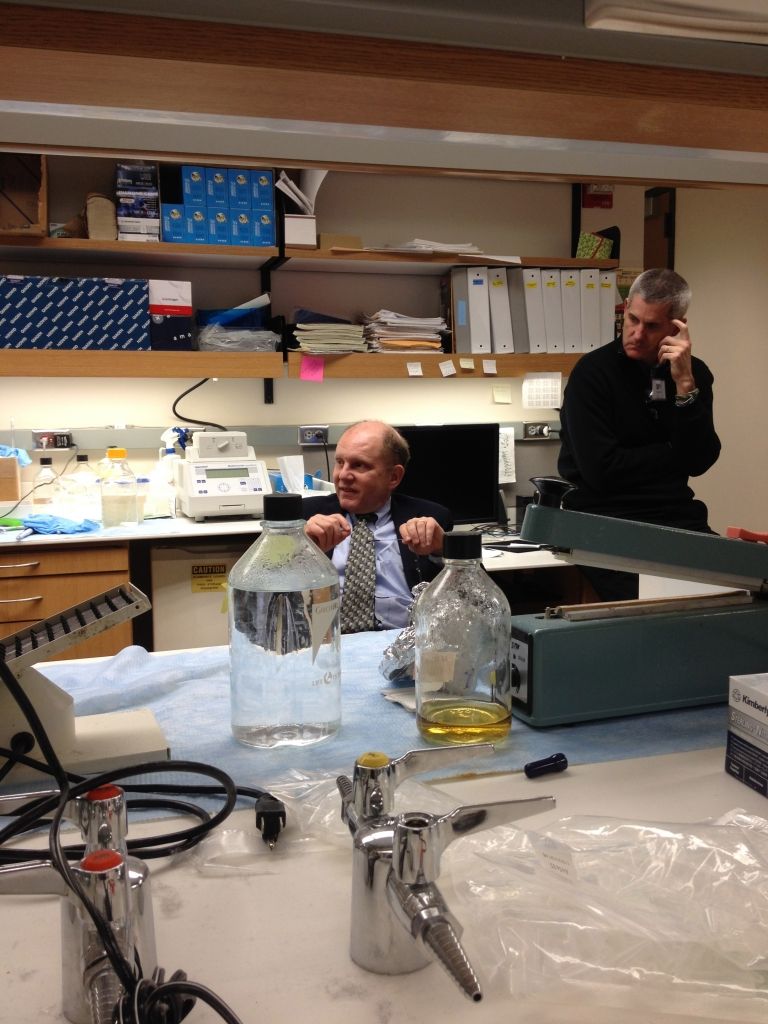 Brian can feel his brain growing while listening to Dr. Cooper[/caption]
Brian can feel his brain growing while listening to Dr. Cooper[/caption][caption id="attachment_335" align="aligncenter" width="400"]
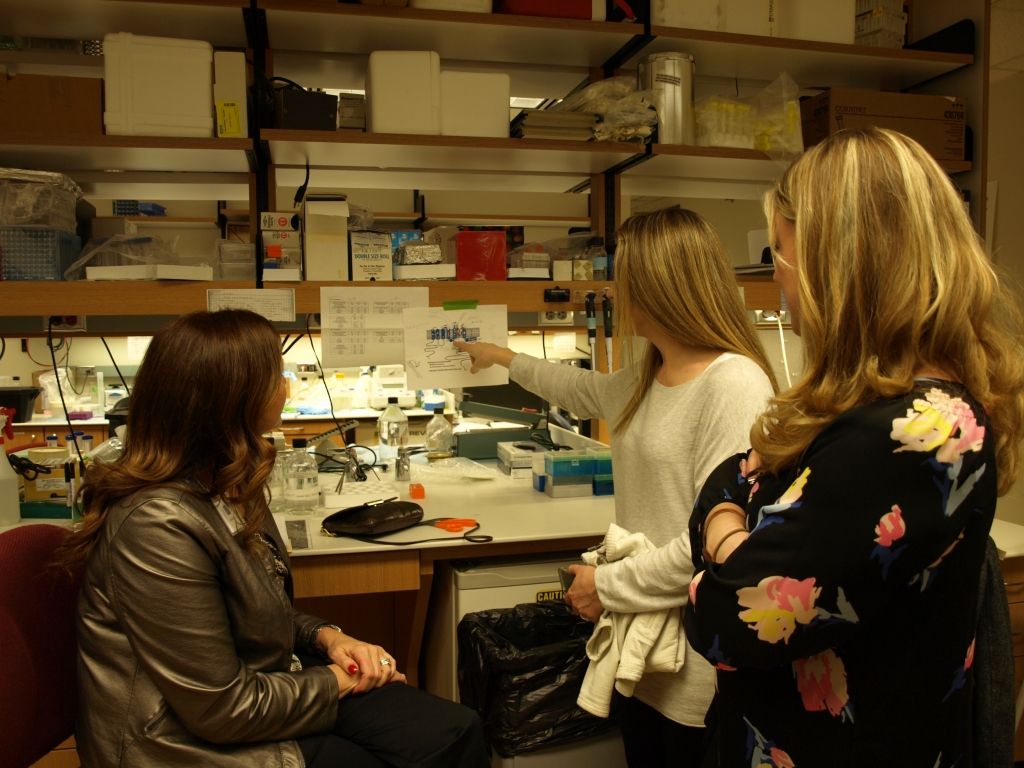 Laura, Scotty, and Liz notice familiar mutation numbers on a diagram. This stuff is starting to make some sense![/caption]
Laura, Scotty, and Liz notice familiar mutation numbers on a diagram. This stuff is starting to make some sense![/caption][caption id="attachment_331" align="aligncenter" width="400"]
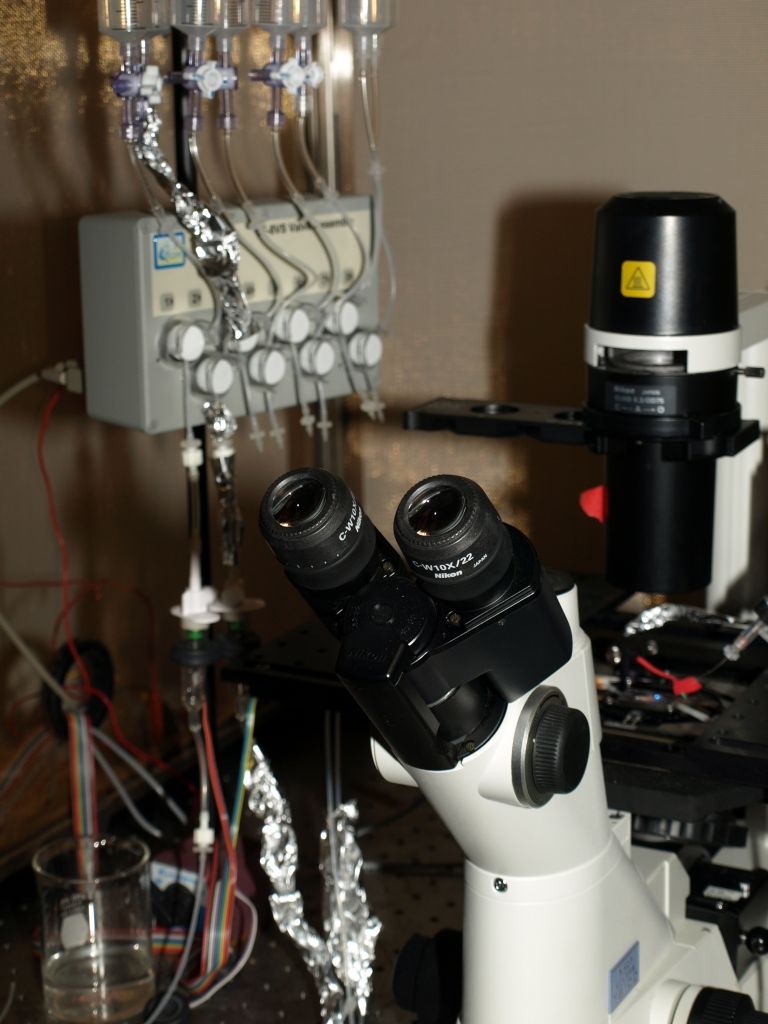 Our tour included a peek at some cells with the KCNQ2 defect.[/caption]
Our tour included a peek at some cells with the KCNQ2 defect.[/caption][caption id="attachment_324" align="aligncenter" width="400"]
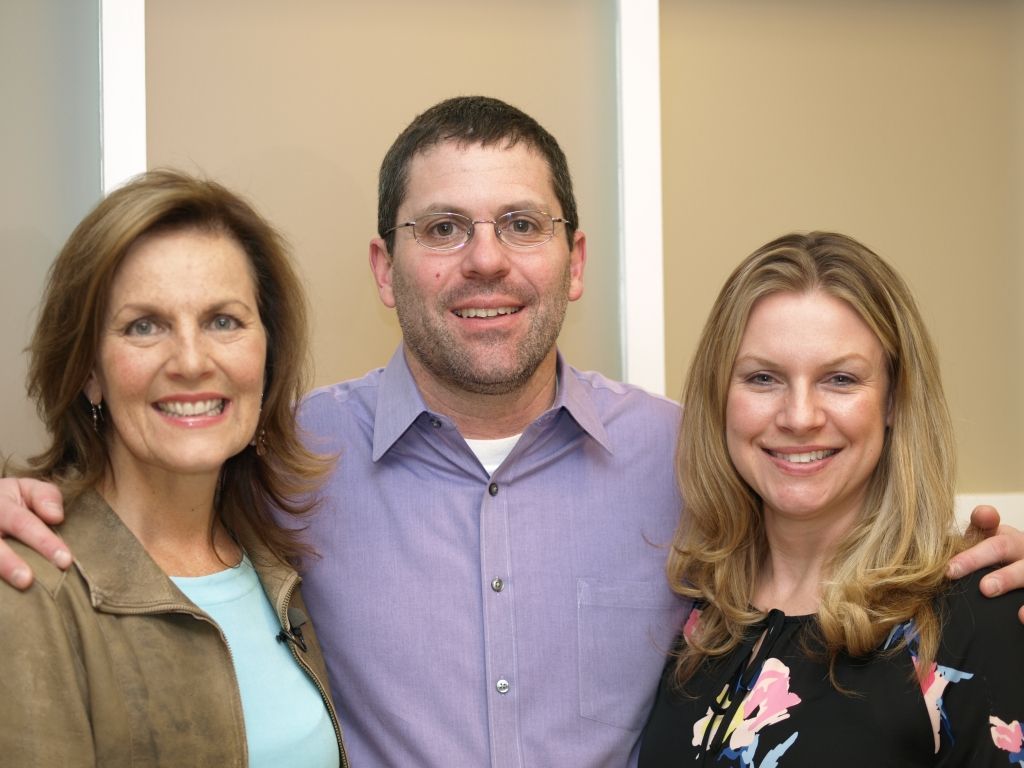 Sara, Mike, and Liz stop for a picture[/caption]
Sara, Mike, and Liz stop for a picture[/caption][caption id="attachment_338" align="aligncenter" width="400"]
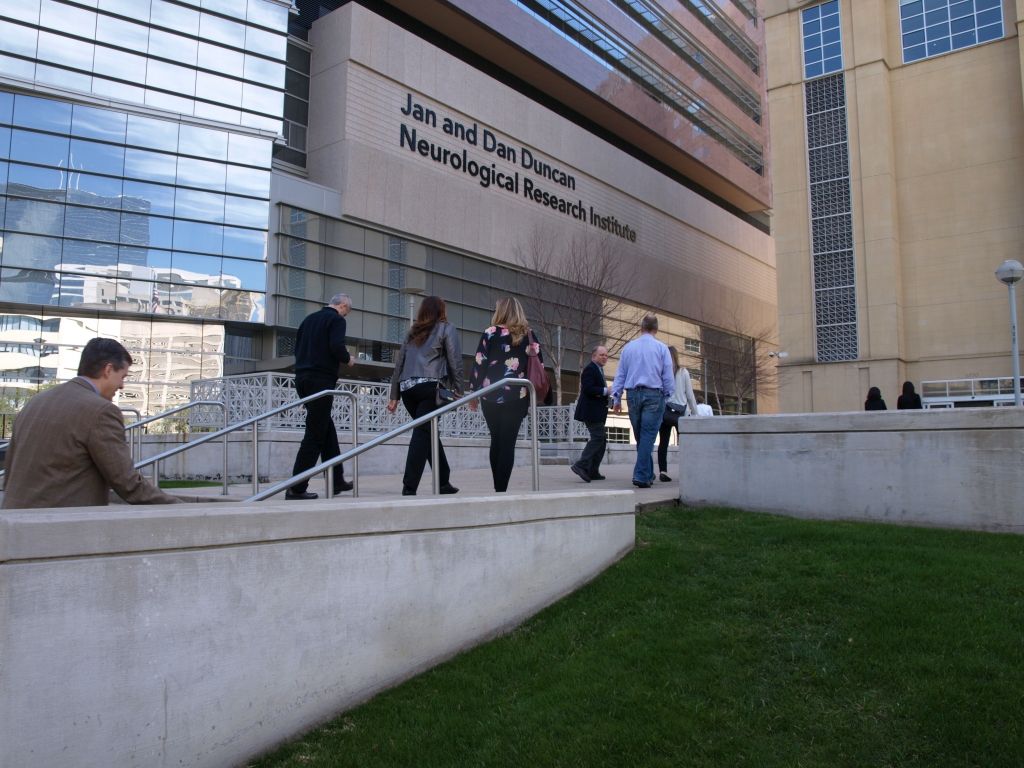 We enjoyed the fresh air and walk to lunch on the Baylor Medical campus[/caption]
We enjoyed the fresh air and walk to lunch on the Baylor Medical campus[/caption][caption id="attachment_339" align="aligncenter" width="400"]
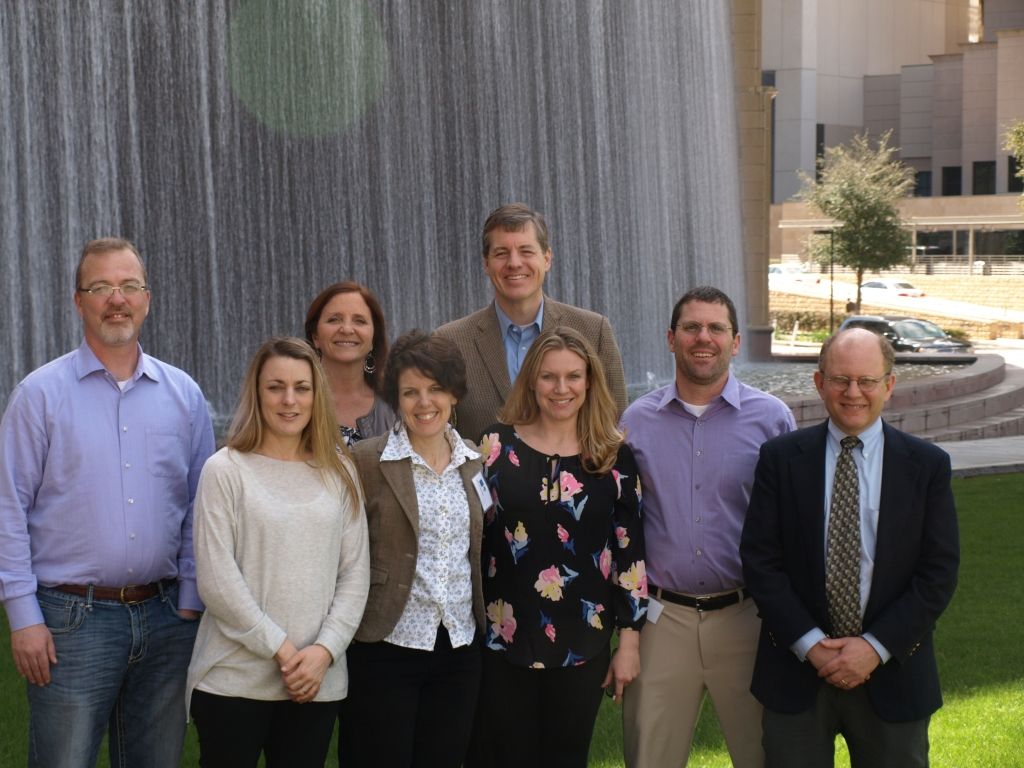 Impressive waterfall feature![/caption]
Impressive waterfall feature![/caption][caption id="attachment_373" align="aligncenter" width="400"]
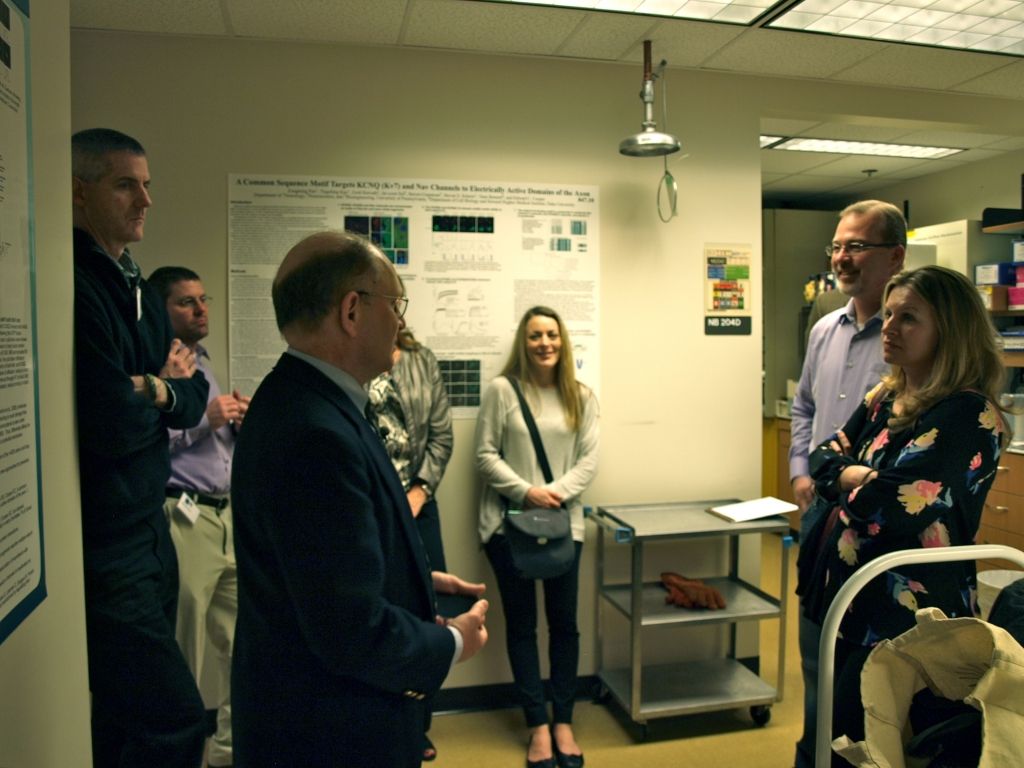 Touring the lab[/caption]
Touring the lab[/caption][caption id="attachment_359" align="aligncenter" width="400"]
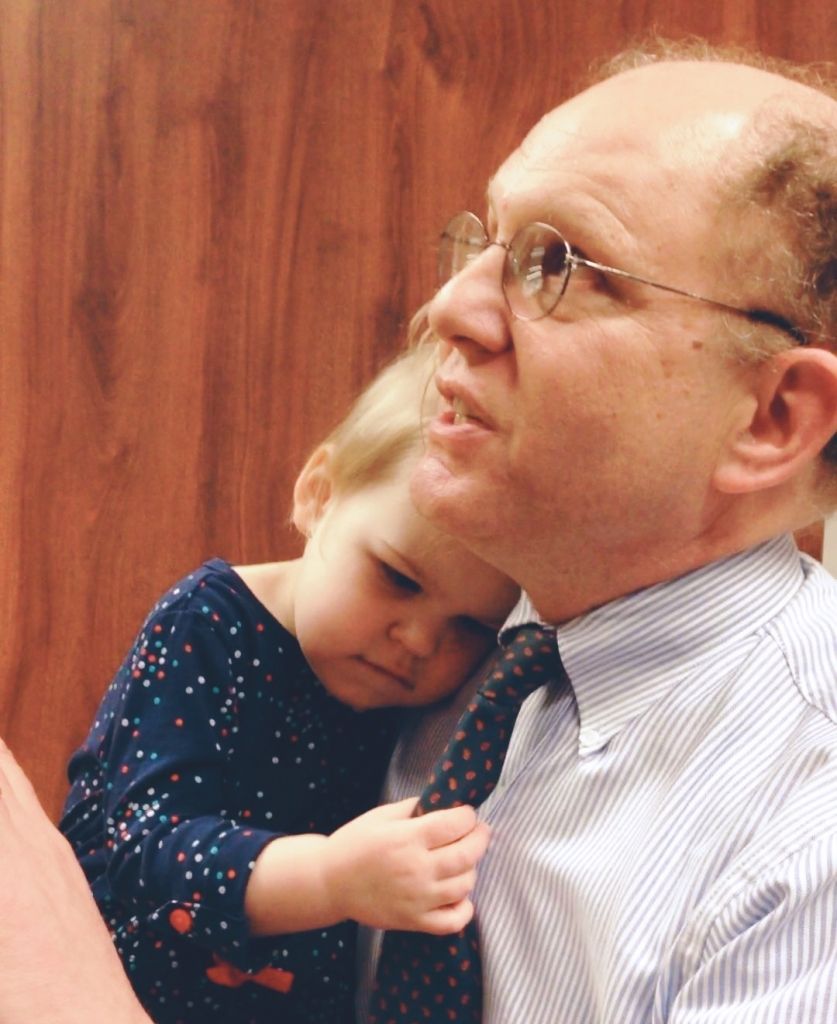 Harper and Dr. Cooper. This is what it's all about: helping the kids[/caption]
Harper and Dr. Cooper. This is what it's all about: helping the kids[/caption] 
